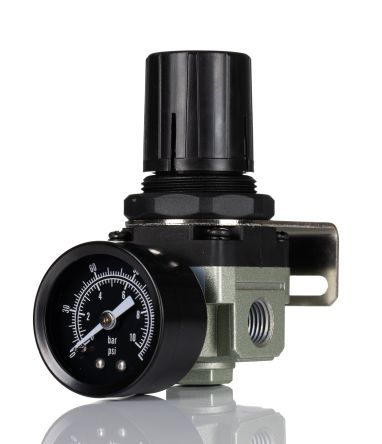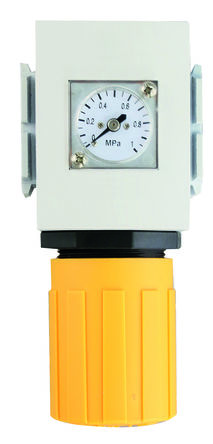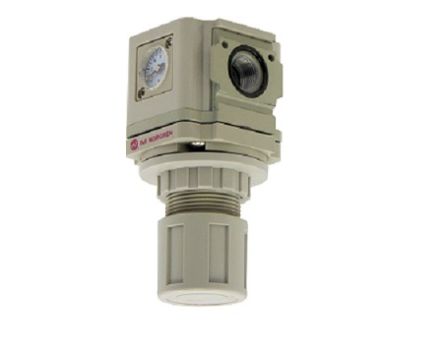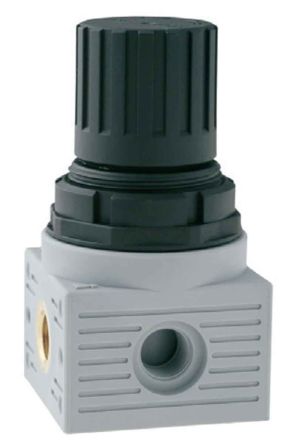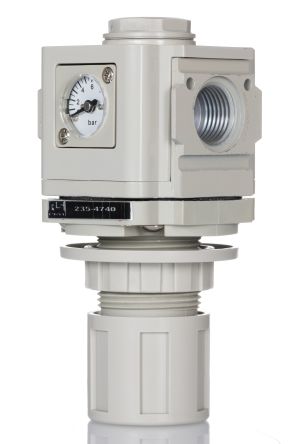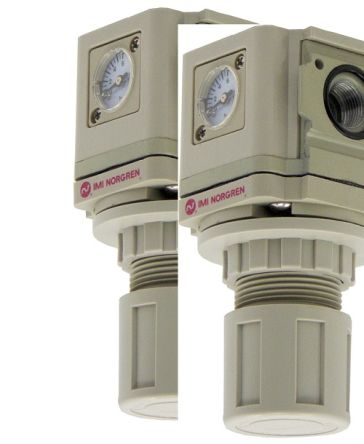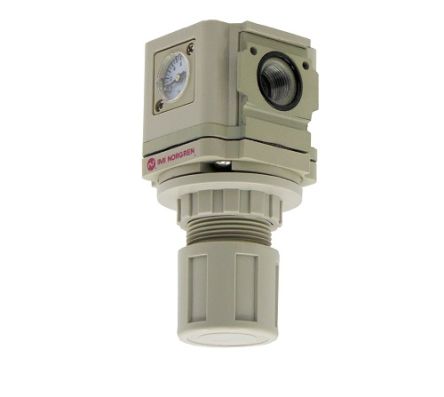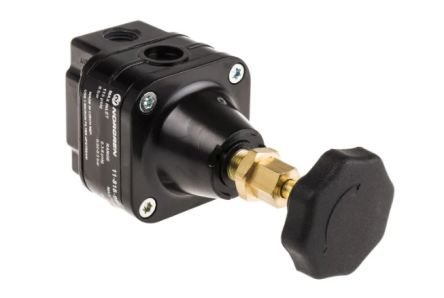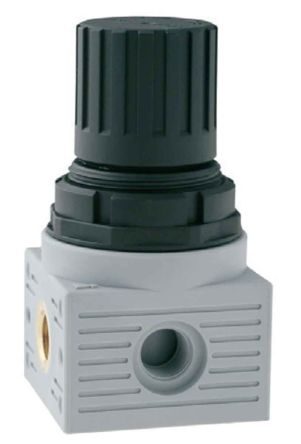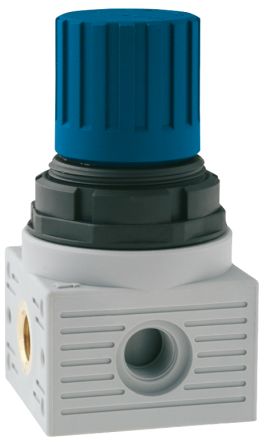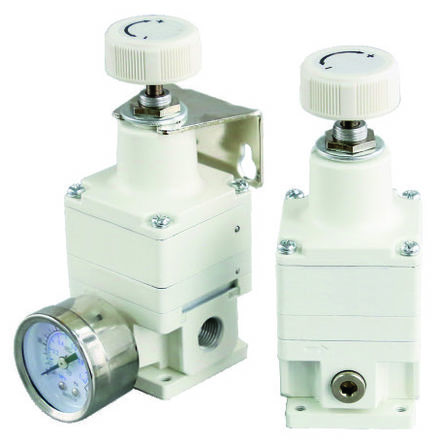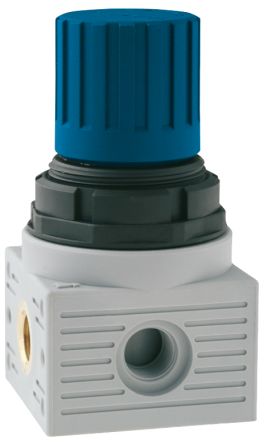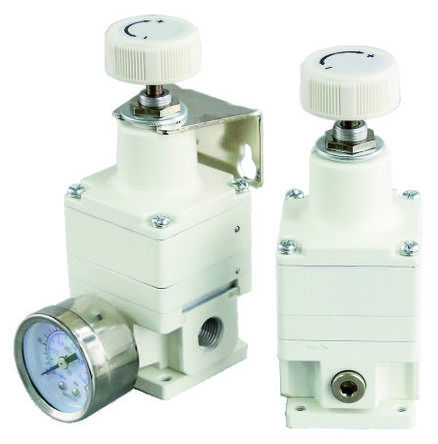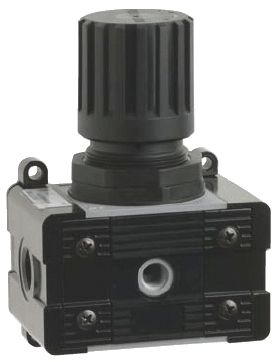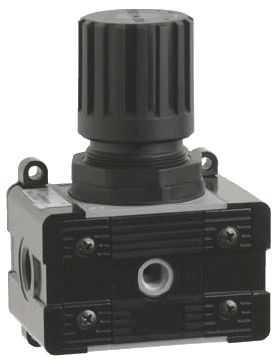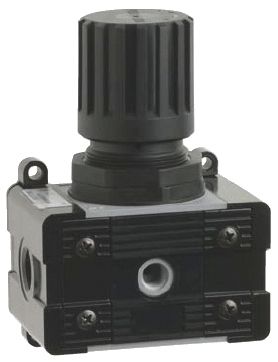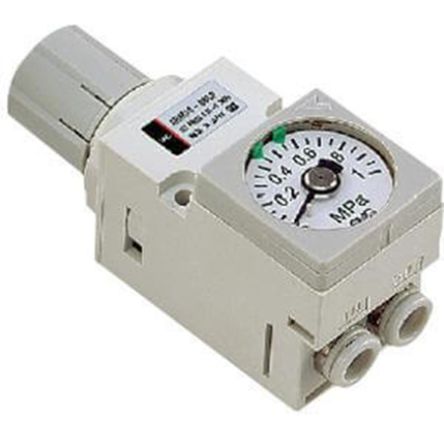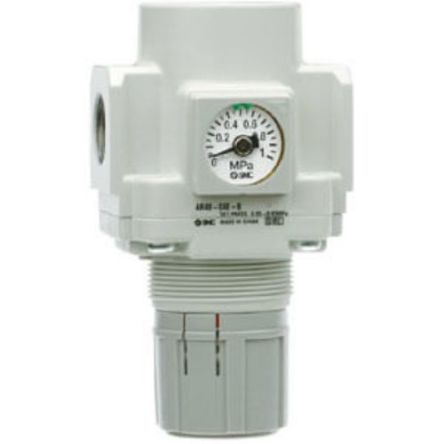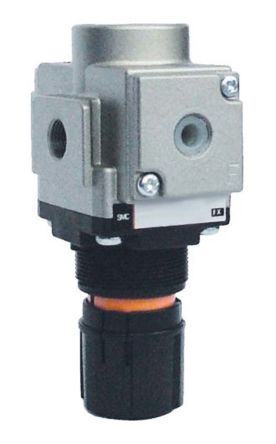- Automation & Control Gear
- Cables & Wires
- Enclosures & Server Racks
- Fuses & Circuit Breakers
- HVAC, Fans & Thermal Management
- Lighting
- Relays & Signal Conditioning
- Switches
- Batteries & Chargers
- Connectors
- Displays & Optoelectronics
- ESD Control, Cleanroom & PCB Prototyping
- Passive Components
- Power Supplies & Transformers
- Raspberry Pi, Arduino, ROCK, STEM Education & Development Tools
- Semiconductors
Pneumatic Regulators
Pneumatic regulators, also known as pressure-reducing valves, are used in pneumatic systems to maintain the output air pressure. They are commonly used in pneumatic air compressors.
Pneumatic regulators provide quick response and accurate pressure regulation for demanding industrial air preparation applications, making sure that compressed air in a pneumatic system is not wasted.
How Does a Pneumatic Regulator Work?
Pneumatic regulators play a crucial role in maintaining output pressure by automatically cutting off the flow of gas or liquid when a specific pressure level is detected. Most regulators utilise simple wire coil springs to control this pressure effectively.
When installing a pressure regulator, it’s essential to select one that is appropriately sized for your specific system and pneumatic fittings. Choosing a regulator that is too large can lead to increased air usage and energy waste. Therefore, ensuring the correct size is vital for optimal performance and efficiency.
What are the Types of Pneumatic Regulators?
Pneumatic regulators come in various types, each designed for specific applications and requirements. Here are some of the most common types:
- General-purpose regulators: These are versatile regulators that can be used in a wide range of applications. They offer good performance and reliability at a moderate price.
- Precision regulators: Precision regulators are designed for applications that require precise pressure control, offering high accuracy and stability for critical applications like oxygen ventilators.
- Filter regulators: Also known as air prep units, these regulators combine an air pressure regulator with a filter to remove impurities and moisture from the compressed air. This helps to protect downstream equipment and ensure the quality of the air supply.
- Relieving regulators: Designed to automatically vent excess pressure when it exceeds a certain level, these regulators prevent damage to equipment and systems in case of overpressure conditions.
- Non-relieving regulators: These regulators do not have a built-in pressure relief mechanism. They are typically used in applications where the risk of overpressure is low or where a pressure relief valve is already installed elsewhere in the system.
Why is Precise Pressure Control Important in Pneumatic Systems?
Precise pressure control is crucial in pneumatic systems to ensure optimal performance, safety, and efficiency.
- Ensures consistent performance: Maintaining consistent pressure levels ensures that pneumatic equipment operates reliably and predictably, delivering consistent results and minimising downtime.
- Prevents equipment damage: Overpressure or pressure fluctuations can damage sensitive pneumatic components, leading to costly repairs or replacements. Precise pressure control helps to prevent such damage.
- Enhances safety: Overpressure in pneumatic systems can pose a safety hazard, potentially causing equipment failure or even injury to personnel. Precise pressure control helps to maintain safe operating pressures, mitigating potential risks.
- Optimises energy efficiency: Precise pressure regulation helps to optimise energy consumption in pneumatic systems by ensuring that only the necessary amount of compressed air is used. This reduces energy waste and lowers operating costs.
- Improves product quality: In manufacturing processes that utilise pneumatic systems, precise pressure regulation improves product quality by ensuring consistent and controlled operation of pneumatic tools and equipment.
- Extends system lifespan: By preventing overpressure and reducing wear and tear on pneumatic components, precise pressure control can help to extend the overall lifespan of the pneumatic system.
Where are Pneumatic Pressure Regulators Used?
Pneumatic air regulators are found in many common home and industrial applications, including heating furnaces and gas grills as well as in medical and dental equipment. They're ideal when pressure must be closely controlled, as is the case when dealing with gas.
Pneumatic Regulator VS Pressure Relief Valve
While both pneumatic air pressure regulators and pressure relief valves play important roles in pneumatic systems, they serve distinct functions and operate differently.
- Function: Pneumatic regulators primarily control and maintain a consistent output pressure in a pneumatic system, ensuring that downstream equipment receives the correct pressure for optimal operation. Meanwhile, pressure relief valves are designed to protect the system from overpressure by venting excess pressure.
- Operation: Air compressor regulators continuously monitor and adjust the output pressure to maintain a setpoint. In contrast, pressure relief valves remain inactive until the pressure exceeds a predetermined threshold, at which point they open.
- Usage: Pneumatic regulators are used to ensure consistent and controlled pressure, while pressure relief valves are used as safety devices to prevent overpressure.
- Design: Pneumatic regulators consist of a valve body, a diaphragm, and a spring mechanism to control pressure. However, pressure relief valves employ a spring-loaded valve that opens when the pressure exceeds a setpoint.
- Pressure control: Air compressor regulators provide more precise and adjustable pressure control compared to pressure relief valves. The former allows for fine-tuning of the output pressure, while the latter offers a more basic form of pressure control.
- System impact: Pneumatic regulators directly influence the operating pressure of the pneumatic system, unlike pressure relief valves, which act as a preventive safety mechanism.
Things to Consider When Choosing an Air Compressor Regulator
- Inlet pressure: The inlet pressure is the pressure of the air entering the regulator. Ensure that the regulator you choose is rated for the maximum inlet pressure of your pneumatic system.
- Outlet pressure: The outlet pressure is the regulated pressure that will be supplied to your equipment, so your regulator should be able to provide the desired outlet pressure range for your application.
- Connection port sizes: The connection port sizes of the regulator should match the size of the piping or tubing in your pneumatic system, so as to avoid leaks or flow restrictions.
- Flow rate: Select a regulator with a flow rate capacity, which is the amount of air that can pass through, that meets the demands of your pneumatic equipment.
- Operating temperature: Consider the operating temperature range of your pneumatic system and choose a regulator that can operate reliably within it.
- Size and weight requirements: The size and weight of the regulator may be important considerations, especially if space is limited or if the regulator needs to be portable.
Importance of Maintaining Pneumatic Regulators
Maintaining your pneumatic regulators is crucial for ensuring the optimal performance, safety, and longevity of your pneumatic systems. Here’s why you should maintain your pneumatic regulators:
- Ensures accurate pressure control: Regular maintenance helps to ensure that the regulator accurately controls and maintains the desired output pressure, preventing fluctuations or drifts that could affect the performance of downstream equipment.
- Prevents equipment damage: A poorly maintained regulator can lead to overpressure or pressure instability, which can damage sensitive pneumatic components and lead to costly repairs or replacements.
- Enhances safety: Proper maintenance helps to ensure that the regulator operates safely, preventing potential hazards such as leaks or overpressure conditions that could pose a risk to personnel or equipment.
- Improves energy efficiency: A well-maintained regulator can improve energy efficiency by ensuring that the pneumatic system operates at its optimal pressure, minimising air consumption and reducing energy waste.
- Extends equipment lifespan: Regular maintenance can help to extend the lifespan of the pneumatic regulator and other components in the system by preventing wear and tear and ensuring proper lubrication.
- Maintains consistent system performance: Proper maintenance helps to ensure that the pneumatic system operates consistently and reliably, delivering consistent performance and minimising downtime.
Industrial Applications of Pneumatic Regulators
Pneumatic regulators are essential components in a wide range of industries, providing precise and reliable pressure control for various applications. Here are some examples of how pneumatic regulators are used in different sectors:
- Manufacturing: Pneumatic regulators are used extensively in manufacturing to control the pressure of compressed air used for powering tools, equipment, and automated systems. For instance, they ensure consistent pressure for pneumatic flow valves in automated assembly lines.
- Automotive: In the automotive industry, pressure regulators for air compressors are used in applications like air brakes, suspension systems, and tyre inflation systems.
- Aerospace: Pneumatic regulators play a critical role in aerospace applications, controlling the pressure of air used for various systems, such as flight controls, landing gear, and cabin pressurisation.
- Pharmaceutical: The pharmaceutical industry relies on air regulators for air compressors to control the pressure of gases and liquids in processes like mixing, filling, and packaging of pharmaceutical products.
- Food and beverage: Pneumatic regulators often feature in packaging, bottling, and conveyance processes in the food and beverage industry.
- Oil and gas: The oil and gas industry requires the control of gas and liquid pressure in pipelines, storage tanks, and processing equipment, which is provided by pneumatic regulators.
- Medical and healthcare: Pneumatic regulators are used to regulate the pressure of gases used in ventilators, anaesthesia machines, and other medical equipment.
- Textiles: Industry processes, such as weaving, spinning, and dyeing of textiles, rely on pneumatic regulators to ensure smooth and efficient function.
- Construction: Pneumatic tools like nail guns, jackhammers, and air compressors are frequently used in construction. These tools require pneumatic regulators to ensure their proper function.
- Electronics and semiconductor: Various manufacturing processes in the industry, such as etching, deposition, and cleaning of semiconductor wafers, also see the use of pneumatic regulators. For example, they are used to control the pressure of gases used in pneumatic cylinder sensors for precise movement and positioning.
Trusted Pneumatic Regulator Manufacturer, Supplier & Distributor in Australia
RS is a reliable provider of pneumatic regulators in Australia, catering to residential, commercial, and industrial applications. We offer a wide range of pneumatic regulators and pressure reducing valves from top brands like Festo, SMC, Norgren and more.
Buy Pneumatic Regulators Online from RS
Shop pneumatic regulators at RS Australia with fast and reliable nationwide shipping. Visit our Delivery Information page to learn more about shipping options and timelines.
